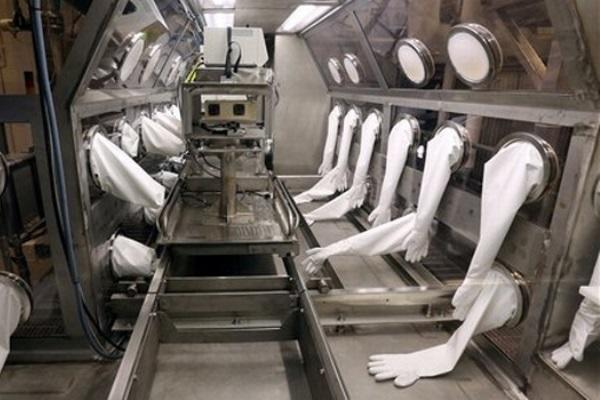The Defense Department failed in the oversight of its high-containment laboratories leading up to the anthrax scandal and also mismanaged the program to fix crumbling infrastructure at its vast array of facilities for chemical and biological defense, the Government Accountability Office reported.
In addition, Pentagon officials last week said that Defense Department has yet to determine how much money was spent on the botched 10-year program that shipped live anthrax samples around the nation and the world to laboratories and contractors for experimentation.
After nearly seven years of trying, DoD's Chemical Biological Defense Program (CBDP) has failed to reach its goal of identifying or correcting shortcomings at facilities in its inventory, the June 25 report by the non-partisan GAO said.
"While the CBDP Enterprise should continue to address its priorities, it remains important that it also ensures that its infrastructure is aligned to meet its mission given ever-changing threats," the GAO said in its report to Congress, the DoD and the Joint Chiefs of Staff.
"The CBDP Enterprise has made limited progress in achieving this infrastructure goal because CBDP Enterprise officials told GAO that they were focused on higher priorities and had no CBDP Enterprise-wide impetus to address the infrastructure recommendations," the report said.
The GAO recommended that DoD "designate an entity to lead the effort to identify required infrastructure," and also coordinate with other federal agencies "to avoid potential duplication."
In response, Assistant Defense Secretary Arthur Hopkins concurred with the GAO's recommendations and said "the Department is actively reviewing and assessing the core capabilities and infrastructure that are crucial to supporting the research, development, testing and evaluation of effective counter-measures against chemical and biological threats."
In an appendix to the report, the GAO noted that the infrastructure problems were part of a systematic failure of oversight and coordination across DoD programs and other federal agencies on chemical-biological defense and testing.
In 1999 and 2000, "we found ineffective coordination among the DoD and other federal agencies with chemical and biological programs that could result in potential gaps or overlap in research and development programs," the GAO said.
Fourteen years later, in July 2014, "we testified before the House Committee on Energy and Commerce Subcommittee on Oversight and Investigations on recent incidents at government high-containment laboratories and the need for strategic planning and oversight of high-containment laboratories," the GAO said.
Transporting Live Samples by Ziploc Bags
The "recent incidents" referred to were at the Centers for Disease Control laboratories. The CDC found that its bioterrorism labs were storing anthrax in unlocked refrigerators and transporting live samples in Ziploc bags.
CDC officials later told a congressional panel that the lax security was "completely unacceptable" and "should never have happened."
In addition to the DoD review on the anthrax scandal, the CDC is now also conducting a separate investigation of how live anthrax samples were mistakenly shipped by DoD facilities.
In its June report, the GAO also noted a previous September 2009 report which concluded that "without an entity responsible for oversight and visibility across the high-containment laboratories and a strategy for requirements for the laboratories, there was little assurance of having facilities with the right capacity to meet the nation's needs."
The 2009 report cited DoD's Chemical and Biological Defense Program (CBDP), DoD's Defense Advanced Research Projects Agency's Biological Warfare Program, the Department of Energy's Chemical and Biological Nonproliferation Program, and the Counterterror Technical Support Program.
All of those programs "lacked information on prioritized user needs, lacked validated chemical and biological defense equipment requirements, and lacked information on how these programs relate their research and development projects to needs," the report said.
Live Spores Sent to Five Countries
In the anthrax scandal, the DoD was about three weeks into a 30-day review ordered by Deputy Defense Secretary Bob Work and led by Frank Kendall, the under secretary for acquisition, over what went wrong in the shipment of live anthrax spores by Federal Express and other commercial shippers to labs and contractors in the U.S., Japan, Canada, Australia, South Korea and Britain.
The Pentagon has stressed that there is no threat to the general public but at least 31 military and civilian personnel at facilities which received the samples were put on antibiotics as a precaution.
Last week, Army Col. Steve Warren, a Pentagon spokesman, said that an unidentified lab in North Carolina was added to the list of facilities that received live anthrax samples, bringing the currently known total to 70.
The states which received live anthrax samples totaled 19: California, Utah, Texas, Tennessee, Virginia, Massachusetts, Wisconsin, Maryland, New Jersey, New York, Delaware, Washington, Illinois, Florida, Arizona, Ohio, North Carolina, Rhode Island and Pennsylvania.
The DoD's purpose in the shipments was to encourage research on better testing methods and an improved vaccine, and also to develop a field testing device that potentially could be used by troops.
Warren said that the DoD has now tested a total of 91 lots of anthrax samples in its inventory and 11 of those have turned up positive for live spores. All of the live samples have been traced to the Army's Dugway Proving Ground in Utah as the origin, Warren said.
An appendix to the GAO report said that officials at Dugway, known as the West Desert facility, "have identified gaps in subject-matter expertise in molecular biology, virology, chemical engineering, analytical chemistry, aerosol-dissemination technology, information technology, catalysis, and automation technology."
"According to West Desert officials, government compensation restrictions will likely preclude the hiring of full-time personnel in the areas of information technology and chemical engineering," the report said.
In response to queries from Military.com, Pentagon officials last week provided an initial estimate of how much was spent on the anthrax shipments but later said the figures were inaccurate and may have applied to all programs at four facilities -- Dugway, the Edgewood Chemical and Biological Defense Center (ECBC) in Maryland, the Naval Medical Research Center (NMRC) in Marylan , and the United States Army Institute of Infectious Diseases (USAMRIID) in Maryland.
At the June 4 announcement of the 30-day review, Kendall said that it will be difficult to determine how much money was spent and how much live anthrax was sent around the states and the world until the review is complete. "The numbers are in flux," he said.
-- Richard Sisk can be reached at Richard.Sisk@military.com.





























